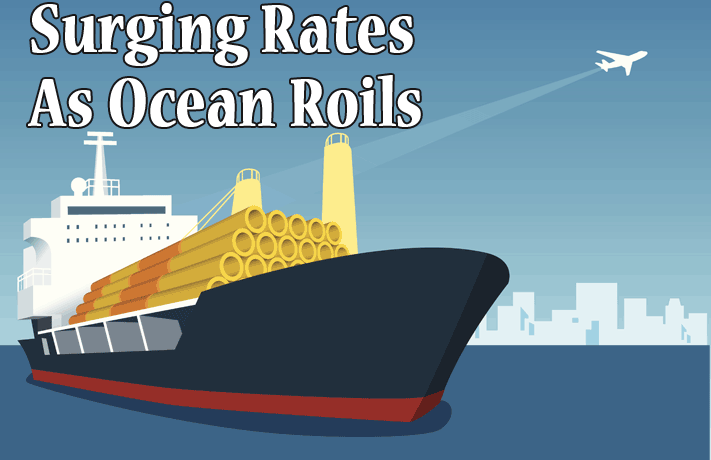|

Transpacific air freight markets gathered
further steam this week as port and hinterland chaos on the U.S. West
Coast showed no sign of resolution, according to a survey of leading executives
conducted by Flying Typers.
One air cargo forwarding VP who asked not
to be named said both demand and spot rates from major Asian hubs had
been on “a steep” upward curve while a run on aircraft capacity
for the last two weeks had seen charter rates surge.
 David G. Ross, (right) Managing Director
of the Stifel Transportation & Logistics Research Group, predicted
current chaos at U.S. ports would continue to hike costs for shippers.
“The bottom line, in our view, is that domestic freight rates as
well as trans-Pacific airfreight rates near term should increase with
congestion-driven supply shortages, benefiting providers of logistics
services and expedited delivery, while retailers and consumers should
bear the burden of these higher costs,” he said.
David G. Ross, (right) Managing Director
of the Stifel Transportation & Logistics Research Group, predicted
current chaos at U.S. ports would continue to hike costs for shippers.
“The bottom line, in our view, is that domestic freight rates as
well as trans-Pacific airfreight rates near term should increase with
congestion-driven supply shortages, benefiting providers of logistics
services and expedited delivery, while retailers and consumers should
bear the burden of these higher costs,” he said.
Li Wenjun, Head of Air Freight, DHL Global
Forwarding Asia Pacific, said DHL had secured additional air freight capacity
on all major trade lanes into the U.S. and had also received a number
of requests from customers seeking air chartering solutions for cargo
usually shipped by sea. “We expect air freight volumes to grow as
more shipments are being diverted from ocean freight due to US port congestion
and delays,” he added.
 Robert
van de Weg, (left) Senior Vice President Sales & Marketing, AirBridgeCargo,
said delays at Long Beach and other West Coast ports, and the perceived
threat of a complete strike, had boosted airfreight to the USA during
November. However, although AirBridgeCargo has allocated extra capacity
and been performing additional flights into U.S. markets, he said shippers
were not acting out of desperation. Robert
van de Weg, (left) Senior Vice President Sales & Marketing, AirBridgeCargo,
said delays at Long Beach and other West Coast ports, and the perceived
threat of a complete strike, had boosted airfreight to the USA during
November. However, although AirBridgeCargo has allocated extra capacity
and been performing additional flights into U.S. markets, he said shippers
were not acting out of desperation.
“Many shippers did not want to take
a risk, it seems, to reach the market before Thanksgiving,” he said.
“At the same time, there is no complete panic and things are not
moving at any cost.
“We expect the peak situation to moderate
after Thanksgiving days - unless the labor situation worsens of course."
U.S. retailers have been managing the threat
of slowdowns and closures of West Coast ports for much of the year. This
included shipping early or via alternate ports and using air freight as
a last resort.
“The current congestion issues are
impacting the delivery of last minute  hot
holiday merchandise, replenishment inventory as well as early spring merchandise,”
said Jonathan Gold, (right) National Retail Federation Vice President
for Supply Chain and Customs Policy. hot
holiday merchandise, replenishment inventory as well as early spring merchandise,”
said Jonathan Gold, (right) National Retail Federation Vice President
for Supply Chain and Customs Policy.
“Retailers are doing everything they
can to ensure that products will be on the store shelves for the busy
holiday shopping season.”
With little sign that port congestion will
ease even after the holiday season, DHL has told its major clients to
take three strategic steps to ensure future  deliveries
are not also disrupted. “First, use multiple carriers who can provide
multiple port options,” said David Goldberg, (left) Head of Ocean
Freight, DHL Global Forwarding Asia Pacific. “By spreading out the
traffic we can isolate delays and maintain a fairly consistent delivery
schedule. deliveries
are not also disrupted. “First, use multiple carriers who can provide
multiple port options,” said David Goldberg, (left) Head of Ocean
Freight, DHL Global Forwarding Asia Pacific. “By spreading out the
traffic we can isolate delays and maintain a fairly consistent delivery
schedule.
“Second, maintain an option through
the Canadian Gateways and East Coast. Having an existing footprint on
those services will allow for some cargo to move without too much delay.
“Lastly, they should have access to
critical material at origin in case they would need to replace cargo on
the water which could move via air.”
SkyKing |





